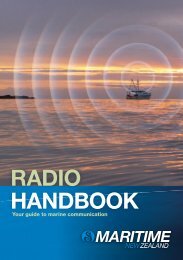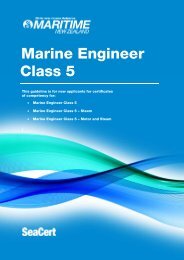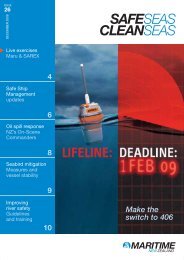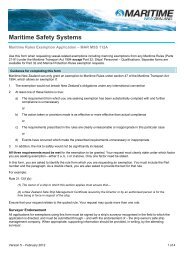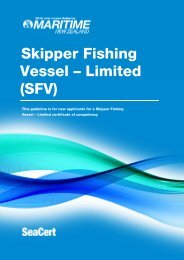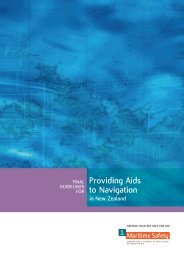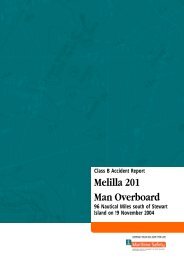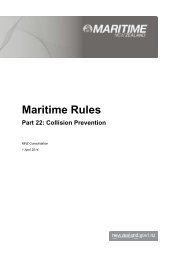New Zealand oil spill response strategy - Maritime New Zealand
New Zealand oil spill response strategy - Maritime New Zealand
New Zealand oil spill response strategy - Maritime New Zealand
You also want an ePaper? Increase the reach of your titles
YUMPU automatically turns print PDFs into web optimized ePapers that Google loves.
de-escalated. This is to ensure consistency and decrease the likelihood of <strong>response</strong> decisions<br />
becoming misinterpreted. It also safeguards against costs being unaccounted for.<br />
In a long-running <strong>response</strong>, it may be practical for the agency or OSC in control to delegate some or<br />
all functions to another agency and demobilise under-utilised resources. The resources involved in a<br />
<strong>response</strong> may be increased or decreased at various times according to operational requirements.<br />
Responsibility for completing the <strong>response</strong> remains with the higher level agency or OSC.<br />
Response Termination<br />
Termination criteria will be determined in consultation with community representatives and appropriate<br />
stakeholders. This will take into account a wide range of values unique to the individual nature of each<br />
incident, based on the principles of net environmental benefit assessment. Ultimately, the final<br />
decision to terminate a <strong>response</strong> lies with the OSC under section 304 of the Act and in the case of a<br />
Tier 3, with the consent of the Director. It will also represent the cessation of funding for any further<br />
cleanup costs.<br />
Command and Control<br />
Emergencies such as <strong>oil</strong> <strong>spill</strong>s require prompt, decisive and informed action. A clear and effective<br />
command and control system is essential, as is the knowledge and expertise required to implement<br />
that system. The initial phase of a <strong>response</strong> may be critical with little time available for assessment of<br />
the situation and the need for action to be taken as soon as possible. In order to ensure that the initial<br />
phase of a <strong>response</strong> is effective and efficient, it is essential that adequate resources are mobilised<br />
immediately. This is particularly important upon declaration of a Tier 3 <strong>response</strong> when the NOSC and<br />
key personnel may have some distance to travel to the incident location. Accordingly, a minimum initial<br />
<strong>response</strong> team structure and size has been determined for Tier 3 incidents.<br />
The <strong>New</strong> <strong>Zealand</strong> Coordinated Incident Management System (CIMS) has been adopted by the Ministry<br />
for Civil Defence and Emergency Management and a wide range of agencies involved in emergency<br />
<strong>response</strong> including <strong>Maritime</strong> <strong>New</strong> <strong>Zealand</strong> and local government. <strong>Maritime</strong> <strong>New</strong> <strong>Zealand</strong> continues to<br />
be involved in the development and coordination of CIMS at the national level.<br />
CIMS is designed to improve emergency <strong>response</strong> management through better coordination between<br />
the organisations involved. CIMS is also a flexible system that enables different agencies to carry out<br />
their statutory obligations without unnecessary alteration to internal operational procedures. The focus<br />
of CIMS is on inter-agency operations rather than the internal operations of the various agencies.<br />
<strong>New</strong> <strong>Zealand</strong>’s marine <strong>oil</strong> <strong>spill</strong> command and control system is compatible with CIMS and is not<br />
dissimilar to the systems employed in most developed countries. Details on <strong>New</strong> <strong>Zealand</strong>’s system<br />
and how CIMS is incorporated during <strong>spill</strong> <strong>response</strong> are contained in the National Plan.<br />
Response Options<br />
OSCs are legally entitled to take whatever action is appropriate and necessary to clean up and/or<br />
mitigate the effects of a marine <strong>oil</strong> <strong>spill</strong> under the Act. In determining the correct <strong>response</strong> options for<br />
each circumstance, the OSC is expected to judge options according to net environmental benefit<br />
assessment (NEBA). This process ensures that any <strong>response</strong> option results in the best environmental<br />
outcome.<br />
The <strong>spill</strong>er, while being responsible for any costs associated with the <strong>response</strong>, may not be the legal<br />
owner of the <strong>oil</strong>. In whatever form or condition the <strong>oil</strong> is finally recovered, it still remains the property<br />
of the original owner. If practical, the OSC may consult with the original owner or their agent to<br />
determine their preferred course of action. However, the ultimate responsibility for decisions<br />
concerning recovery or disposal of <strong>oil</strong>y waste remains solely with the OSC. Once waste has been<br />
collected and contained it must also be disposed of in accordance with any regional rules governing<br />
waste disposal made under the RMA.<br />
Monitoring<br />
Monitoring can be broadly described as either Type 1 (operational) or Type 2 (non-operational/<br />
scientific). Type 1 provides information of direct relevance to the <strong>spill</strong> <strong>response</strong> operation, and<br />
generally refers to cost recoverable monitoring prior to <strong>response</strong> termination. Type 2 includes any<br />
16





